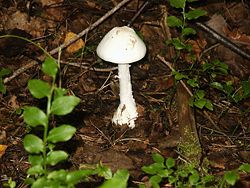Amanita virosa
For the course duration, the article is closed to outside editing. Of course you can always leave comments on the discussion page. The anticipated date of course completion is May 21, 2009. One month after that date at the latest, this notice shall be removed. Besides, many other Citizendium articles welcome your collaboration! |
 | ||||||||||||||||
| Scientific classification | ||||||||||||||||
| ||||||||||||||||
| Binomial name | ||||||||||||||||
Classification and naming
Amanita virosa or the European destroying angel is one of a group of deadly pure white mushroom species collectively known as the destroying angels or the death angels. Amanita virosa is one of the most poisonous of all known toadstools. It belongs to the fungi kingdom; a poisonous basidiomycete fungus, one of many in the genus Amanita.
Amanita virosa was first collected and described by Elias Magnus Fries a Swedish mycologist and botanist.
Description
Amanita virosa is pure white in appearance with gills which are usually not attached to the stalk. The cap of the Destroying Angel is 2¼ to 6 inches wide. In young specimens, a white, membranous partial veil tissue extends from the edge of the cap to the upper stalk, covering the gills and later remaining attached to and draping from the upper stalk. The stalk is white and up to 8 inches long or tall, with a small, rounded bulb at the base; the bulb is enclosed by a sac-like volva. All parts of the Destroying Angel are white and turns bright yellow with the application of potassium hydroxide (KOH). The base of the stalk and the volva are often buried in the soil.
Distribution and habitat
Amanita virosa is found in late summer and autumn under broad leaved trees in mixed woodland, especially in association with beech, on mossy ground. All Amanita species form symbiotic relationships with the roots of certain trees.